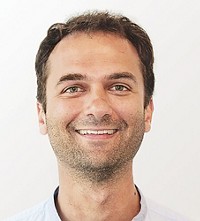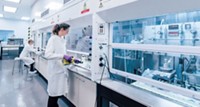Advertisement
Grab your lab coat. Let's get started
Welcome!
Welcome!
Create an account below to get 6 C&EN articles per month, receive newsletters and more - all free.
It seems this is your first time logging in online. Please enter the following information to continue.
As an ACS member you automatically get access to this site. All we need is few more details to create your reading experience.
Not you? Sign in with a different account.
Not you? Sign in with a different account.
ERROR 1
ERROR 1
ERROR 2
ERROR 2
ERROR 2
ERROR 2
ERROR 2
Password and Confirm password must match.
If you have an ACS member number, please enter it here so we can link this account to your membership. (optional)
ERROR 2
ACS values your privacy. By submitting your information, you are gaining access to C&EN and subscribing to our weekly newsletter. We use the information you provide to make your reading experience better, and we will never sell your data to third party members.
Business
Seeding A Province
Government of Quebec partners with venture capital firm on a seed fund to spur biotech innovation
by Lisa M. Jarvis
June 21, 2010
| A version of this story appeared in
Volume 88, Issue 25
It’s rough out there for the budding biotech entrepreneur. These days, finding cash to pull a project out of an academic lab or to conduct tests that prove an idea’s merit can be nearly impossible. For venture capitalists, the value generated from a start-up business is low, and the risk is often too high.
Officials from Quebec are trying to shake up the funding model in hopes of spurring innovation—and job creation—in the Canadian province. The government has handed over a pot of money to GeneChem, a Montreal-based venture capital firm run by scientists, to find and fund the best and brightest minds in the region.
For years, Quebec has been one of the top 10 biotech hubs in North America, but the province’s government recently noticed a decrease in the number of start-up firms emerging from the region. And the environment for new companies seems only to be getting worse. The economic crisis created a capital crunch throughout the biotech industry in which early-stage funding has become particularly hard to come by.
“To the extent that there’s capital available, in most venture capital firms a lot of that money is going to later stage companies,” says G. Steven Burrill, chief executive officer of the investment firm Burrill & Co. The gap in funding for entrepreneurs who want to do the first few experiments to validate an idea “is probably greater than it’s ever been,” he adds.
Last fall, recognizing the economic and industry forces that entrepreneurs were up against, Quebec’s government unveiled a biopharmaceuticals strategy designed to help new and existing companies adapt.
As part of a package that includes the usual R&D tax credits and calls for collaboration, the government created a $40 million biotech seed fund to be run by a private venture capital group. That group would also raise its own cash contribution. The fund would provide small amounts of money to Quebec-based start-ups culled from local universities and research institutes, with the goal of reviving innovation in the region. In October, the government asked interested venture capitalists to compete for the right to run the fund.
GeneChem came up with the winning proposal, a fund called AmorChem, after analyzing its own funding activities since its 1997 launch. The results surprised the financiers: Although most of the $300 million they invested over the years had gone to U.S. companies, when they gave out seed funding to start-ups, about half of it went to Canadian firms. Furthermore, local firms receiving funds had been the best performers.
Drilling down into those local investments, GeneChem assembled a list of “lessons learned” to apply to the government fund. The firm found that it had the most success when it was one of only a couple of investors in a start-up and when the investment was small. When a company is launched with a small amount of cash, a healthy return on the investment is more easily achieved, and the pool of potential future investors is larger. The venture capital firm also learned that there isn’t much to be gained financially from conducting a Phase I trial for most therapeutic indications. Better to sell a molecule and let someone else do the toxicity screening.
However, the most important lesson, says Inès Holzbaur, a GeneChem vice president and one of several Ph.D. chemists on staff, is that the bigger the infrastructure, the harder it is to pull the plug on a project that isn’t yielding results.
Those lessons informed GeneChem’s strategy for AmorChem. The seed fund will be open for 10 years, although GeneChem hopes to make most of the 40 investments it has planned within the first five years. Each recipient will get an initial injection of no more than $500,000. Leftover cash from failed projects will be funneled to other companies in the fund’s portfolio. The maximum investment per project will be $3 million, and the therapeutic concept must be validated within 18 to 24 months.
To lower costs and avoid duplicating infrastructure, GeneChem plans to establish a small medicinal chemistry company to screen compounds for its start-up firms. “Drug targets are abundant at universities, but chemistry screening is not,” Holzbaur says. Hiring a dozen chemists to make analogs doesn’t make sense for a start-up, yet drug development chemistry needs to be tightly controlled, she adds. The GeneChem-run chemistry company will address those needs.
Once a molecule or technology has been validated, AmorChem expects to either license it or bundle it with other projects into companies with more robust financing. “We believe the licensing will really drive our returns,” Holzbaur says.
Licensing promising projects might seem antithetical to the goal of reinvigorating Montreal’s biotech cluster, but Holzbaur sees an upside for the region. “In order to have a biotech hub, you need to have success stories—like a company raising $50 million or being sold,” she acknowledges. “But you also need people who are in the game a short time, make some money, and catch the bug and want to do it again.”
Holzbaur has seen GeneChem’s previous seed investment funds spread the entrepreneurial fever. This time she believes the process will lead not only to wealth creation in Quebec but also to a community of new, prosperous biotech firms.
GeneChem hopes to raise its contribution for AmorChem by the beginning of the fourth quarter. Once the fund is launched, the next step will be to scour the labs of local universities for winning ideas.








Join the conversation
Contact the reporter
Submit a Letter to the Editor for publication
Engage with us on Twitter